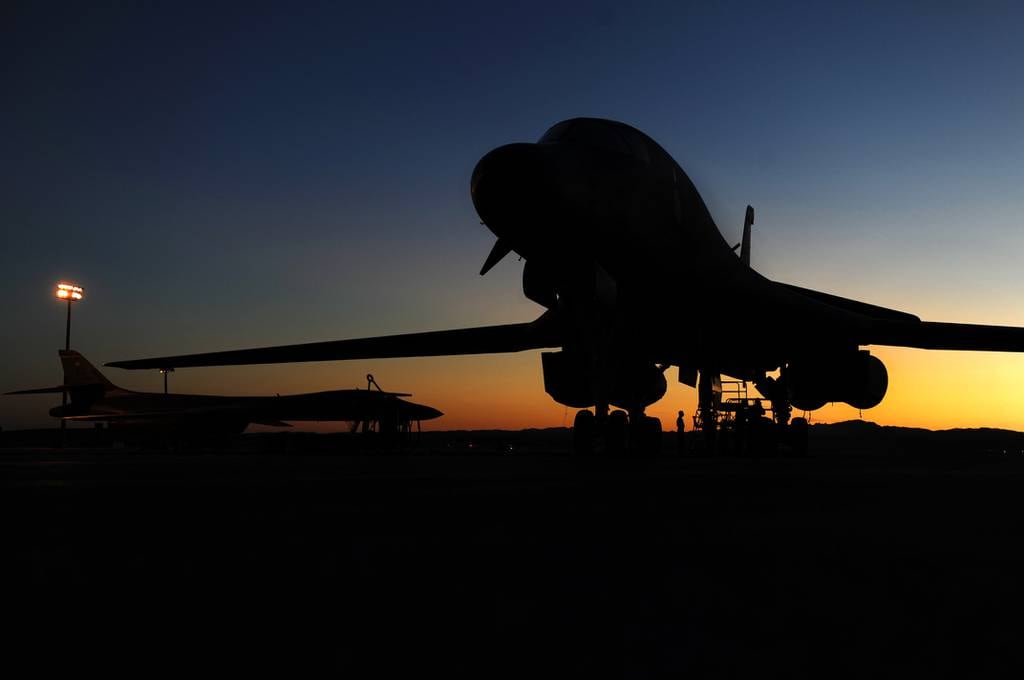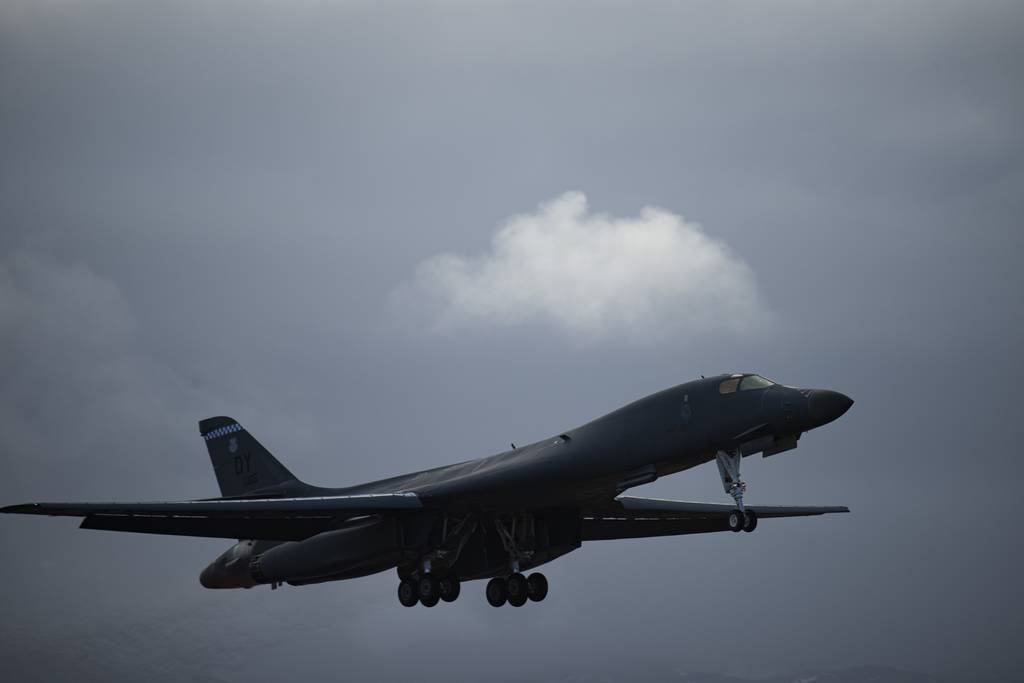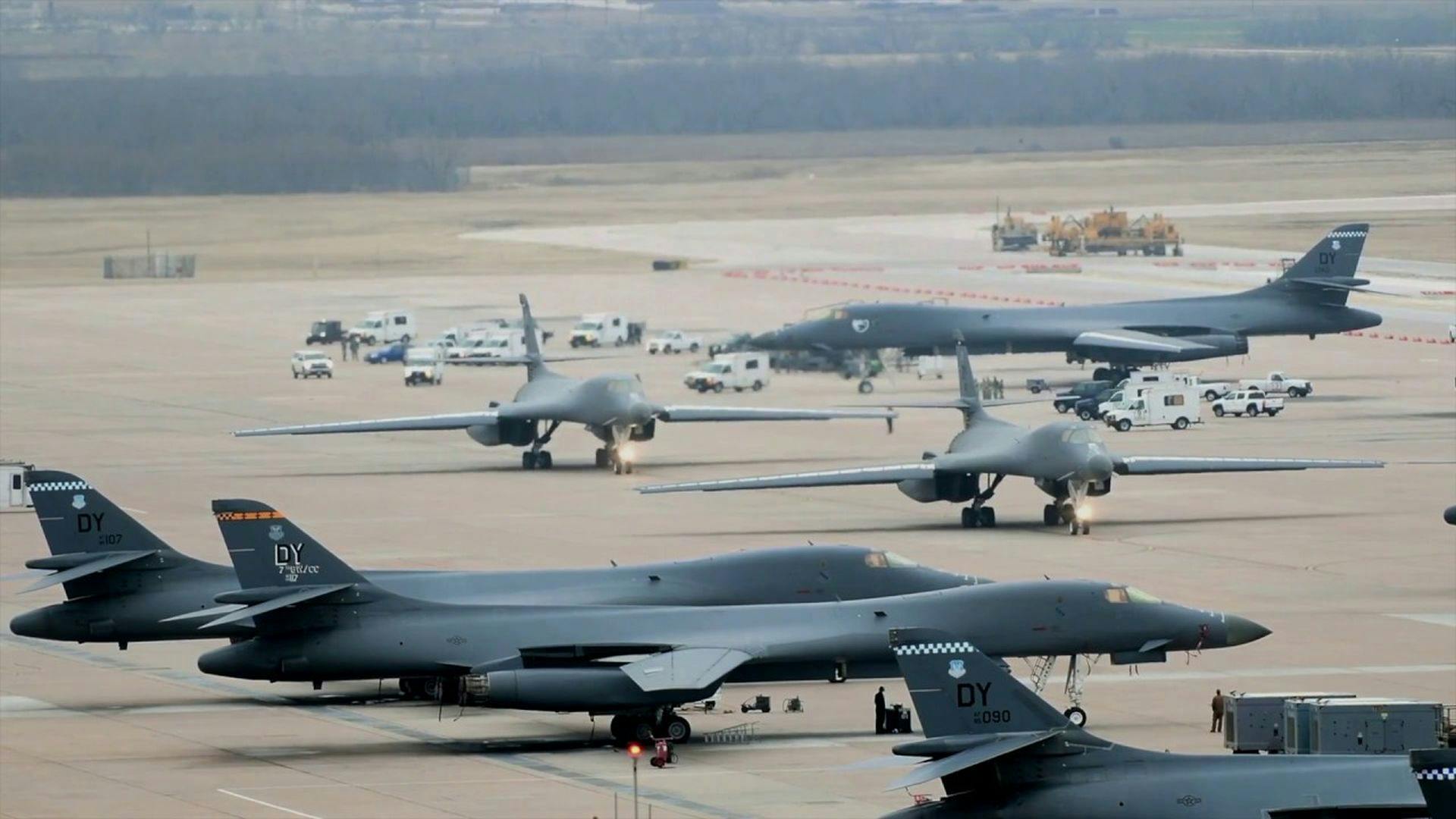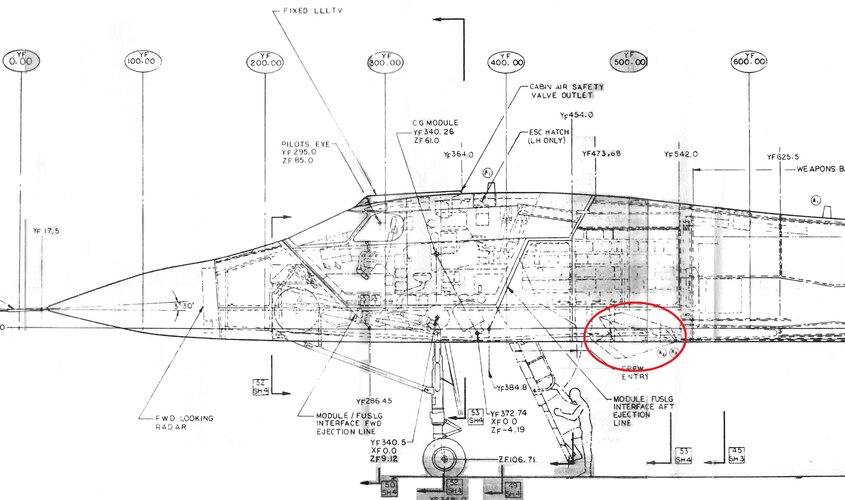It was still there 16 years ago, but never used.Heh. I'd read about the self-darkening ports like. .. back in the 80s but hadn't seen anything about them since then. They're like the auto-darken welding hoods you can get. Speaking of long-forgotten details (to me) does the B-1B have the button on the back of the nose gear that the crew can hit on their way to the cockpit that starts all four engines?
You are using an out of date browser. It may not display this or other websites correctly.
You should upgrade or use an alternative browser.
You should upgrade or use an alternative browser.
North American Rockwell / Boeing B-1 Lancer
- Thread starter flateric
- Start date
- Joined
- 9 October 2009
- Messages
- 19,766
- Reaction score
- 10,213

US B-1 bombers arrive in Norway in historic first
U.S. Air Force B-1B Lancers from Dyess Air Force Base in Texas arrived in Norway on Monday as part of a training mission in Europe, marking the first time U.S. bombers have operated out of the…

The ‘Bone’ heads to the boneyard
The Air Force retired the first of 17 B-1 bombers planned to be divested as part of the fiscal 2021 budget.
- Joined
- 21 January 2015
- Messages
- 10,641
- Reaction score
- 12,234
View: https://mobile.twitter.com/TheDEWLine/status/1365646837391237121
I personally think we never got our money's worth on B-1B. If they'd sold the idea of a $150 million bomber in the 1980s on it becoming an amazing CAS platform for land-locked Afghanistan, I doubt it would have been approved. And it could never do the mission it was designed for.
- Joined
- 3 June 2011
- Messages
- 17,288
- Reaction score
- 8,963
I guess he thinks the only thing the B-1B has ever done in it's career is drop bombs on camels in Afghanistan.View: https://mobile.twitter.com/TheDEWLine/status/1365646837391237121
I personally think we never got our money's worth on B-1B. If they'd sold the idea of a $150 million bomber in the 1980s on it becoming an amazing CAS platform for land-locked Afghanistan, I doubt it would have been approved. And it could never do the mission it was designed for.
Now, now, they did pull some SIOP alert and spent a bunch more time broke on the ramp. Then Desert Fox and Kosovo, where it distinguished itself by letting a malfunctioning towed decoy chase one of them out of theater. All that said, useless dirt I, II, III... saved the airframe. When I showed up to Dyess in Summer 2002 the rest of the fleet was on the chopping block (this was after retiring 1/3 of the fleet). BLOS, JDAM, lack of access close to Iraq/Afghanistan and TST saved the Bone.I guess he thinks the only thing the B-1B has ever done in it's career is drop bombs on camels in Afghanistan.
- Joined
- 3 June 2011
- Messages
- 17,288
- Reaction score
- 8,963
And what
And what did Russia give up to remove it's nuclear capability? How much damage could those weapons have caused? Sounds like a good investment to me.Now, now, they did pull some SIOP alert and spent a bunch more time broke on the ramp. Then Desert Fox and Kosovo, where it distinguished itself by letting a malfunctioning towed decoy chase one of them out of theater. All that said, useless dirt I, II, III... saved the airframe. When I showed up to Dyess in Summer 2002 the rest of the fleet was on the chopping block (this was after retiring 1/3 of the fleet). BLOS, JDAM, lack of access close to Iraq/Afghanistan and TST saved the Bone.I guess he thinks the only thing the B-1B has ever done in it's career is drop bombs on camels in Afghanistan.
That's a bit of a non sequitur as USAF was happy to give up that capability with START I in 1995. While they technically did IOC at the end of 1986 they never were a full up round (so to speak). Up until the early 90's the AFCS problems cut into the range, not to mention the DAS wasn't working right, 1990 engine fires grounded them, summer of 1990 SRAM's were pulled from alert aircraft, 1991 SRAM II was canceled, 1993 SRAM was permanently retired and the ALCM boxes were never purchased. START gave up SIOP in 1995, by that time all they could carry were B-61's and B-83's, the DAS still wasn't fixed, they were still hanger queens, seven years later the fighter boys in the five sided puzzle palace still were looking to get rid of them to buy more F-22's but CENTCOM/CC loved having a big stick that he could directly wield via BLOS through the CAOC. So, the fighter generals ground their teeth and murmured under their breath while the folks from DY/EL got regular vacations to the sandbox.And what did Russia give up to remove it's nuclear capability? How much damage could those weapons have caused? Sounds like a good investment to me.
Now it could be considered a success in that it caused the former USSR to spend money it didn't have on defensive systems to counter it.
- Joined
- 19 July 2016
- Messages
- 3,723
- Reaction score
- 2,680
I believe anything that makes the other side spend more money than they need is a good investment, probably why the Chinese are so good at it.
- Joined
- 21 January 2015
- Messages
- 10,641
- Reaction score
- 12,234
Other than the fact it probably caused Russia to develop a similar aircraft that’s probably better. Not sure you’d call that a win.I believe anything that makes the other side spend more money than they need is a good investment, probably why the Chinese are so good at it.
- Joined
- 3 June 2011
- Messages
- 17,288
- Reaction score
- 8,963
Other than the fact it probably caused Russia to develop a similar aircraft that’s probably better. Not sure you’d call that a win.I believe anything that makes the other side spend more money than they need is a good investment, probably why the Chinese are so good at it.
A dubious claim that, when you factor in their unit-cost, becomes downright comical.
- Joined
- 19 July 2016
- Messages
- 3,723
- Reaction score
- 2,680
I didn't our side were the ones doing it. the Russians and the Chinese sure get value for money, especially when they get the rest to pay for the research too.
- Joined
- 21 January 2015
- Messages
- 10,641
- Reaction score
- 12,234
I doubt their equivalents spend so much time in repair bays than in the air. No wonder the USAF can’t wait to be shot of it and would rather keep the far older but more reliable B-52.I didn't our side were the ones doing it. the Russians and the Chinese sure get value for money, especially when they get the rest to pay for the research too.
I think it would be quite a stretch to describe the B-1 as a successful program. They ended up seeing a lot of use because of their endurance, but I don't think they ever ended up doing anything a B-52 couldn't. They had a fairly short amount of time serving as a deterrent force. They are stunningly beautiful aircraft though, with no shortage of range and payload. I've no doubt that they would have been effective low level penetration bombers (when a given airframe was combat capable), had they been used in that role, but it disappeared post cold war.
- Joined
- 21 January 2015
- Messages
- 10,641
- Reaction score
- 12,234
They look great design wise but everything I’ve read in the area says they are nightmare to keep in the air.I think it would be quite a stretch to describe the B-1 as a successful program. They ended up seeing a lot of use because of their endurance, but I don't think they ever ended up doing anything a B-52 couldn't. They had a fairly short amount of time serving as a deterrent force. They are stunningly beautiful aircraft though, with no shortage of range and payload. I've no doubt that they would have been effective low level penetration bombers (when a given airframe was combat capable), had they been used in that role, but it disappeared post cold war.
Indeed, anecdotally I've heard a B-2 is easier to keep flight worthy. I've also heard that the B-1 fleet could vary very drastically from airframe to airframe and that it was a rather bespoke plane in practice despite technically being a serial run of a hundred.
@Josh_TN as much as I bag on the Bone, it eventually became quite successful, just not at what it was originally intended, thankfully that had just as much to do with the fall of the Iron Curtain as its teething problems, which was a good thing. Ultimately, it could do what nothing else in the fleet could match; transit from over 1,000 nm away from the theater, loiter over a point somewhere over the middle of a country in the sandbox for several hours, fly to any point within a set radius in less than 15 min, communicate directly back to the CAOC, use SAR radar, MTI radar, and use IR/EO targeting pods to deliver JDAM and Laser JDAM. As much as I like the BUFF, it couldn't do all of that, which is not to say that the BUFF doesn't have capabilities the Bone doesn't which better suit it to high end threats.I think it would be quite a stretch to describe the B-1 as a successful program. They ended up seeing a lot of use because of their endurance, but I don't think they ever ended up doing anything a B-52 couldn't. They had a fairly short amount of time serving as a deterrent force. They are stunningly beautiful aircraft though, with no shortage of range and payload. I've no doubt that they would have been effective low level penetration bombers (when a given airframe was combat capable), had they been used in that role, but it disappeared post cold war.
As to the SIOP role and low level, they probably would have done OK, but that has more to do with the ICBM's and SLBM's clearing the way for them. One of my test directors from back in the day was privy to a SIOP briefing on if the Bone could make it to its target set. The briefer gave an unequivocal yes, but he was wearing a missileer badge. Against Mig-31's and Su-27's they'd had a much tougher time, unless you could use a SRAM as an AAM...
Depends on the systems from what I heard. The variability in the Bone fleet came from the 83 & 84 models being essentially hand built. Parts from one airframe wouldn't fit onto the next, they were a frigging nightmare, which is why they were they very first to go. FWIW, one of my crew chiefs got to meet President Bush b/c his plane "Boss Hawg" 84-051 was inducted into the USAF Museum and dedicated as part of the then new Cold War exhibit. The 85's and 86 models were all build off of the same tooling and were much more interchangeable.Indeed, anecdotally I've heard a B-2 is easier to keep flight worthy. I've also heard that the B-1 fleet could vary very drastically from airframe to airframe and that it was a rather bespoke plane in practice despite technically being a serial run of a hundred.
- Joined
- 19 February 2007
- Messages
- 1,095
- Reaction score
- 1,495
Thanks for that insight. After thinking about that for a while, I think I understand why. I *suspect* that the FY 82, 83 and 84 aircraft were built on the B-1A soft tooling that had been stored at B-1A cancellation. I do recall hearing that 82-0001 (Balls One) was built from assemblies originally slated to be B-1A ship 5. Additional B-1A long-lead items (suitably modified) could have been used on the FY 83 & 84 aircraft (the next 18 aircraft).
In parallel (yay concurrency!), high rate production tooling was being built to support the 4-a-month rate that was later reached for the FY 85 and 86 airplanes. (But this is only my speculation.)
In parallel (yay concurrency!), high rate production tooling was being built to support the 4-a-month rate that was later reached for the FY 85 and 86 airplanes. (But this is only my speculation.)
- Joined
- 21 January 2015
- Messages
- 10,641
- Reaction score
- 12,234
It also more quickly gives you an all frontline stealth force. The B-52 I am guessing is moving firmly into the stand-off role.That’s what I’ve heard...the Bone fleet is still larger with the recent retirements but in more desperate need of replacement.
- Joined
- 9 October 2009
- Messages
- 19,766
- Reaction score
- 10,213
Forgot to post this earlier. From four days ago:

 www.airforcetimes.com
www.airforcetimes.com

B-1B Lancers conduct first Bomber Task Force mission from Norway
The exercise highlights the increasing importance of the Arctic in the national defense strategy.
- Joined
- 9 October 2009
- Messages
- 19,766
- Reaction score
- 10,213
From the 3rd of March:

 ukdefencejournal.org.uk
ukdefencejournal.org.uk

US begins retirement of B-1s to make way for for B-21s
The U.S. Air Force has announced that it will retire 17 B-1B Lancers from its current fleet of 62.
 ukdefencejournal.org.uk
ukdefencejournal.org.uk
FighterJock
ACCESS: Top Secret
- Joined
- 29 October 2007
- Messages
- 4,179
- Reaction score
- 3,336
From the 3rd of March:

US begins retirement of B-1s to make way for for B-21s
The U.S. Air Force has announced that it will retire 17 B-1B Lancers from its current fleet of 62.ukdefencejournal.org.uk
It will be sad to see the B-1B be retired, that was the only bomber that nearly deafened me when I saw it at RAF Leuchars airshow back in 1996.
- Joined
- 3 June 2011
- Messages
- 17,288
- Reaction score
- 8,963
Sounds like a successful program to me.I think it would be quite a stretch to describe the B-1 as a successful program. They ended up seeing a lot of use because of their endurance, but I don't think they ever ended up doing anything a B-52 couldn't. They had a fairly short amount of time serving as a deterrent force. They are stunningly beautiful aircraft though, with no shortage of range and payload. I've no doubt that they would have been effective low level penetration bombers (when a given airframe was combat capable), had they been used in that role, but it disappeared post cold war.
- Joined
- 27 September 2006
- Messages
- 5,743
- Reaction score
- 5,607
Reading this thread makes me more underdtanding of Carter cutting B1A in the inflation ridden 70s in order to get the B2 on stream.
The Reagan Arms build up after the Soviet invasion of Afghanistan brought B1 back as a way of adding clout to SAC. I doubt in the early 1980s anyone was worrying about servicability rates 30 years later.
The Reagan Arms build up after the Soviet invasion of Afghanistan brought B1 back as a way of adding clout to SAC. I doubt in the early 1980s anyone was worrying about servicability rates 30 years later.
The B-1 never had a good serviceability rate. It had had huge avionics issues even when it just entered service and I don’t think it’s ECM ever delivered. The engines I think were always touchy and variable geometry introduced another point of failure.
kaiserd
I really should change my personal text
- Joined
- 25 October 2013
- Messages
- 1,665
- Reaction score
- 1,613
The B-1B is a funny case.Reading this thread makes me more underdtanding of Carter cutting B1A in the inflation ridden 70s in order to get the B2 on stream.
The Reagan Arms build up after the Soviet invasion of Afghanistan brought B1 back as a way of adding clout to SAC. I doubt in the early 1980s anyone was worrying about servicability rates 30 years later.
In reality it probably had limited impact on Soviet developments and expenditure, much of which was actually prompted by the cruise missile threat. For example MIG-31 development comfortably predates the decision to order the B-1B; if you can find and shoot down a cruise missile your probably doing the same to a low flying B-1B.
It primary owed its existence to the dynamics of US politics of the time in which it was ordered (at a time where there was little publicly known re: the ATB program).
As mentioned by other contributors it had a troubled introduction and the USSR was dead well before most were ironed out (by which time it’s effectiveness to penetrate Soviet/ Russian defence perhaps were. starting to lack a bit of credibility).
And yet in the limited wars and (especially) the post-9/11 conflicts it found a very different niche. Yet it’s that heavy use, the inherent complexity of the airframe, and some of the underlying issues that never fully went away has the fleet struggling for reliability.
So a great investment or a bad investment that unexpectedly eventually gave some valuable late return? How would anyone ever definitively judge that?
- Joined
- 27 September 2006
- Messages
- 5,743
- Reaction score
- 5,607
Kaiserd You are looking back on the decisions and events of the 80s from the present. I was around throughout the period of the Reagan build up.
Your points are correct. We dont know how significant B1B was or whether it could have carried out its role in the SIOP.
As I wrote above, B1 was adopted from B1A to add another element to the arms build up. And the Sovs were impressed enough to have developed the very similar Tu160 Blackjack.
As for its use in the post Cold War era. I dont think B1 was ever expected to be used in "limited war" roles. Your final paragraph is pretty meaningless in that context. The investment did its job in the 80s and added to the capability of the US Triad. Had the Cold War continued and B2s been introduced in planned numbers, B1s were planned to replace B52s in the stand off roles or as bombers after the B2s had gone in.
Your points are correct. We dont know how significant B1B was or whether it could have carried out its role in the SIOP.
As I wrote above, B1 was adopted from B1A to add another element to the arms build up. And the Sovs were impressed enough to have developed the very similar Tu160 Blackjack.
As for its use in the post Cold War era. I dont think B1 was ever expected to be used in "limited war" roles. Your final paragraph is pretty meaningless in that context. The investment did its job in the 80s and added to the capability of the US Triad. Had the Cold War continued and B2s been introduced in planned numbers, B1s were planned to replace B52s in the stand off roles or as bombers after the B2s had gone in.
Colonial-Marine
UAVs are now friend, drones are the real enemy.
- Joined
- 5 October 2009
- Messages
- 1,187
- Reaction score
- 682
I know they never got the defensive ECM suite working as well as they wanted it to and eventually had to accept that it wouldn't live up to what the brochure promised but with the next generation of weapons (AGM-129 ACM and AGM-131 SRAM II) it would have still played a very useful part in the nuclear mission. I've heard it claimed that those RCS reduction efforts gave the B-1B a frontal RCS similar to an F-16 (pre-Have Glass) so if they did ever get a competent ECM system on there it wouldn't be the easiest target even for the MiG-31.
Considering how the B-1B has been used after being removed from the nuclear mission the faster B-1A would have probably been an even more useful aircraft.
Considering how the B-1B has been used after being removed from the nuclear mission the faster B-1A would have probably been an even more useful aircraft.
kaiserd
I really should change my personal text
- Joined
- 25 October 2013
- Messages
- 1,665
- Reaction score
- 1,613
I literally meant my last paragraph; the B-1B has given long hard and useful service, just not at anything it was really intended for.Kaiserd You are looking back on the decisions and events of the 80s from the present. I was around throughout the period of the Reagan build up.
Your points are correct. We dont know how significant B1B was or whether it could have carried out its role in the SIOP.
As I wrote above, B1 was adopted from B1A to add another element to the arms build up. And the Sovs were impressed enough to have developed the very similar Tu160 Blackjack.
As for its use in the post Cold War era. I dont think B1 was ever expected to be used in "limited war" roles. Your final paragraph is pretty meaningless in that context. The investment did its job in the 80s and added to the capability of the US Triad. Had the Cold War continued and B2s been introduced in planned numbers, B1s were planned to replace B52s in the stand off roles or as bombers after the B2s had gone in.
And the fact is that by a virtue of timing and underlying technical issues it contributed relatively little to the actual capacity of US nuclear forces before the Soviet Union collapsed and it’s notable that even with the B-2 procurement numbers massively cut it was missile armed B-52s, and not B-1Bs, that were retained for the nuclear mission.
So by all means the B-1B (and crew most of all) deserves praise for it actual achievements and successes. Just not for all this phantom stuff that some contributors are claiming that only superficially sounds plausible or rooted in fact.
That is not an entirely accurate statement @Josh_TN, to be fair that does properly describe most of the service life of the aircraft. There are, however, notable exceptions to the general rule. During the 90's congress funded a study which required Ellsworth to receive the mandated spares and support they were supposed to receive. Throughout the duration of the study they were able to maintain the required MC rate. The second notable occurrence was 2002-2005, which were the years I was at Dyess. We broke the records for sustained high MC rates that have never again been replicated. Why? They retired the 83's and 84's and we had spare parts, by 2005 the well had run dry and it was regression back to the mean.The B-1 never had a good serviceability rate. It had had huge avionics issues even when it just entered service and I don’t think it’s ECM ever delivered. The engines I think were always touchy and variable geometry introduced another point of failure.
Sustainment is nowhere near as sexy as procurement and those holding the purse strings have short memories.
Fair enough. I get the impression that the B-21 is truly taking the maintenance issue up as a major point of acquisition, so I *hope* that the replacement will be something more maintainable with a steady stream of parts. If they truly are borrowing the F135 engine without reheat, that would probably help the part stream a lot.
Generally speaking that's the whole idea behind total life cycle procurement. RCO got it off to a good start by requiring mature technologies, nothing worse than having to mature a technology while trying to integrate a complex weapons system. Of course, DoD basically cut out the usually USAF procurement apparatus to acquire B-21. All of that to say, given what's transpired with new bombers since 1960 it's a good thing for some adult in the room to realize, "We better get it right this time..."Fair enough. I get the impression that the B-21 is truly taking the maintenance issue up as a major point of acquisition, so I *hope* that the replacement will be something more maintainable with a steady stream of parts. If they truly are borrowing the F135 engine without reheat, that would probably help the part stream a lot.
isayyo2
Lurker alert
- Joined
- 24 November 2011
- Messages
- 1,034
- Reaction score
- 1,867
2006 MA Thesis on the targeting pod's integration
"A Study To Enhance The B-1B Targeting Pod Integration Developmental Processes"
"A Study To Enhance The B-1B Targeting Pod Integration Developmental Processes"
- Joined
- 9 October 2009
- Messages
- 19,766
- Reaction score
- 10,213
Some interesting information on the B-1B's systems circa late 1982 in the pdf linked below (I'd tried linking a copy to this post in case of more DTIC purges but the pdf was too large). Pages 341 - 377 (pdf pages 355 - 390).
Bubba was the project officer for the Sniper test accel, his thesis is pretty much recounting the project. He went on to command a test squadron and retire as a Lt Col, that should count as acclaim.It's sad not to be able to rationally disagree...
Just to say also that the master study posted just above is an art piece. I can't see how it wouldn't have brought acclamation to the author.
Similar threads
-
North American Rockwell/General Dynamics Phase B Shuttle specs
- Started by Triton
- Replies: 3
-
North American Aviation project for a "V-2 launched" interceptor
- Started by vulture
- Replies: 15
-
All Weather Flying Center and Project Thunderstorm Aircraft.
- Started by Orionfield
- Replies: 17
-
-
North American Rockwell VTXTS proposal (" T-2X ")
- Started by Triton
- Replies: 5

